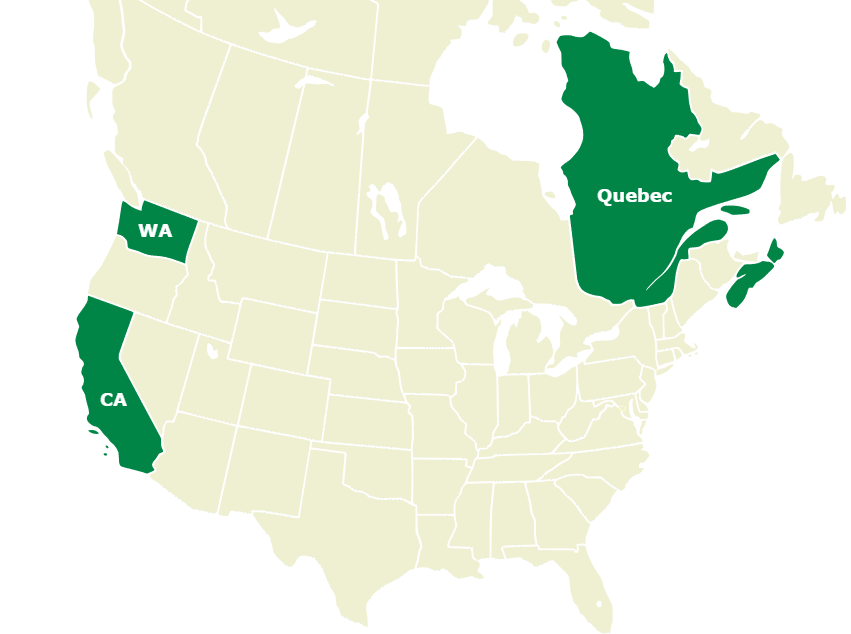As the urgency to combat climate change intensifies, regional efforts in the Western United States and Canada are gaining traction. California, Quebec, and Washington are forging ahead with plans to link their carbon markets, a move that could significantly impact emissions trading dynamics. Let’s delve into the latest developments shaping this convergence.
The three jurisdictions plan to work together to form a bigger carbon credit market. Their proposed alliance could take effect in 2025 at the earliest.
California Carbon Market’s Regulatory Review
The California Air Resources Board (CARB) is expected to submit a standardized regulatory impact assessment (SRIA) to the state’s Department of Finance as part of amending the cap-and-trade program, also known as the compliance carbon market. This assessment will evaluate potential changes to the program, with CARB planning to release a draft of the proposed changes.
The last SRIA submitted by CARB for amending the cap-and-trade program was on June 25, 2018.
Amidst this regulatory plan, secondary market prices for California Carbon Allowances (CCA) showed strength, building on the previous week’s gains. Contracts for both April and December delivery futures saw robust trades. The CCA V24 December 2024 contract trades between $39.60/mt and $40.56/mt on the Intercontinental Exchange (ICE).
Similarly, the ICE CCA V24 April 2024 contract traded at $38.05/mt and $38.80/mt. These prices represent an upward trend compared to the assessments from last Thursday, indicating a positive market outlook.
Meanwhile, Regional Greenhouse Gas Initiative (RGGI) prices show a trend for an upward trajectory, with December delivery contracts showing strong trading activity. Contracts for ICE RGGI V24 December 2024 traded at $20.39/st and $20.40/st.
April delivery contracts also demonstrated positive momentum, indicating potential all-time highs.
Market analysts view the filing of the California Cap-and-Trade SRIA as a bullish signal for the market. It can help maintain regulatory momentum.
Cross-Border Emissions Trading Collaboration
In Quebec, updates to its cap-and-trade program are also anticipated, with a draft regulation expected by September and amendments slated for enactment by December. Quebec’s carbon credit market was linked with California’s program in 2014 to enhance liquidity.
To facilitate this cross-border trading and ensure accurate accounting of greenhouse gas (GHG) emissions reductions, California and Quebec developed an accounting mechanism in place. This mechanism assesses Quebec’s progress towards its GHG emissions reduction targets by considering its domestic emissions inventory and the emission allowances traded between Quebec and California.
Having its own carbon pricing mechanism in place, Canada’s recent carbon price hike won’t impact Quebec. But the province can voluntarily adopt the federal carbon pricing system.
In Washington, Carbon Allowance secondary market prices remained stable, with no observed trades. However, recent legislative actions and announcements by the Washington Department of Ecology regarding the second quarterly cap-and-invest auction scheduled for June 5, continue to influence market sentiment.
Washington Takes a Legislative Leap
Washington State has taken significant steps to integrate its cap-and-invest market with those of California and Québec by signing Senate Bill 6058 into law. This legislation aims to streamline the process of linking Washington’s carbon program with the established joint California-and-Québec cap-and-trade programs.
The new law introduces several amendments to Washington’s Climate Commitment Act, including adjustments to compliance periods, allowance purchase limits, and offset credit usage rules. These changes will align Washington’s regulations with those of California and Québec, facilitating potential linkage agreements between the jurisdictions.
Key provisions of the legislation include:
- Adjusted compliance periods to align with those of California and Québec, allowing for synchronization of regulatory frameworks.
- Expanded allowance purchase limits (25%) and increased flexibility in offset credit usage to promote market efficiency and integration.
- Removal of specific dates from compliance period language to accommodate potential linkage agreements and ensure regulatory consistency.
- Provision for rulemaking by the Washington Department of Ecology to further align cap-and-invest policies with the requirements for linkage.
This legislative development follows joint announcements by California, Québec, and Washington expressing their intent to explore linking their carbon markets. If successfully implemented, a linked program would enable joint auctions of allowances and establish a uniform allowance price across jurisdictions.
Ecology Director Laura Watson remarked that:
“As long as we are linked by Nov. 1, 2027, entities that are required to comply in Washington can use allowances from the larger market to meet their Washington compliance obligation.”
Despite fluctuations in market prices, regulatory developments and auction outcomes can significantly shape the trajectory of carbon credit markets.
By integrating their carbon trading systems, Washington, Quebec, and California aim to enhance the effectiveness of their climate mitigation efforts. This collaboration exemplifies a commitment to regional cooperation in reducing greenhouse gas emissions and addressing climate change.

